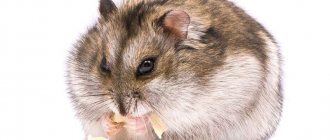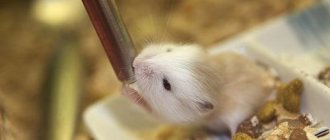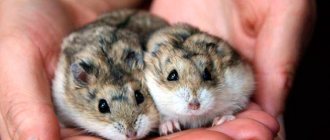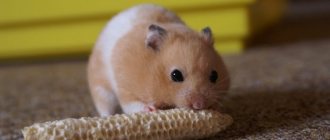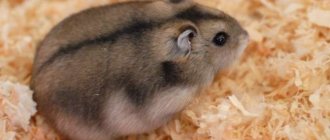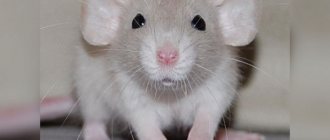Keeping Djungarian hamsters
Dzhungarik hamster photo
Hamsters, like babies, need thoughtful living conditions. Djungarians need special care, which is not difficult to provide. First, we determine the location for the cage. It should not stand on the floor or near an open window. A Djungarian hamster can get a serious cold.
By the way, a serious mistake is exposure to direct sunlight. The animal may overheat and die. But even if the cage is not in poor lighting, dampness is not conducive to normal life. Hamsters are nocturnal animals and too bright light during the day does not bring them pleasure. Since they are active at night, try not to place the cage in the bedroom.
Methods for determining the age of a hamster
Often sellers who do not breed these animals do not provide accurate information about the age of the hamster. Selecting a young individual is quite difficult. There are a number of indirect signs that should be taken into account. First of all, you need to weigh the animal. An animal older than 3 months weighs more than 30 g. If the rodent is too obese, this indicates its old age.
In addition, you should pay attention to your pet's behavior. The younger the animal, the more active it is. An older hamster may look lethargic and sleepy most of the time. It is imperative to examine the eyes and fur. If the rodent is covered with soft fluff and has small bald patches, it means that it is about 2 weeks old. Cloudy eyes and dull fur are the main differences between sick and old individuals.
Temperature for keeping hamsters
Ideally 17-20 °C. Air humidity 40 - 70 percent. High humidity negatively affects the heat exchange of living beings. Dry air is also dangerous - if the cage is located less than 2 meters from the battery. As a result, the animal may develop metabolic disorders.
A hygrometer will help keep the situation under control. Think about your pet in advance when ventilating the room so as not to leave him in a draft.
Before getting a hamster, you need to think about its needs in advance. The first thing you need to do is buy a suitable home for your future pet. Many people rely on the opinion of the seller at the pet store, but in vain. After all, the wrong choice not only threatens constant stress for the rodent, but can also lead to injury.
Coat types
Through the work of breeders, four separate subspecies of Syrian hamsters have been bred. These subspecies are distinguished by the following types of coat. The most common and common is the short-haired type. With such plush-like fur, different colors look best.
Long-haired Syrians have also been bred, another name for which is Angora. Males of this subspecies have a kind of “skirt” of long (8 to 10 cm) hair in the lower part of their body. However, the females look like ordinary Syrians, perhaps a little fluffier. In foreign pet stores, this variety is called “Teddy Bear hamster”.
The Satin or Satin Syrian hamster is distinguished by fur with a special, almost glossy sheen. This effect was achieved by breeding a new variety whose fur contained hollow hairs. However, individuals of Satin Syrians cannot be mated with each other, since this may result in the birth of animals with sparse hair or its complete absence.
Rex (or Curly) hamsters give the impression of being disheveled animals - the hairs in their lush outfit are slightly curled. In addition, rexes also have curled mustaches. This variety can be either short(-) or long-haired.
The last variety is represented by Hairless Syrian hamsters. They are characterized by a complete absence of hair. However, animals with such a fixed mutation sometimes still have a certain velvety appearance and even short “whiskers”.
Unfortunately, representatives of hairless Syrians are quite sickly, they require special care: in unfavorable temperature conditions, some owners even “dress” them. In addition, the life expectancy of a hairless Syrian hamster is half that of normal.
Cage for dzhungarika. Basic principles
Think about the size of your home. According to research, the pallet must be at least 50x30 cm. This is the minimum living space, despite the fact that the area of the floors is not taken into account. A small pallet leads to stress, to obesity, it can gnaw on the cell, and therefore live less than expected.
The cage for the dwarf should be low (dunes for rodents are also sold). A small second floor is allowed, but the third floor is clearly superfluous. The hamster may fall and hurt itself. The second floor should not be made of twigs so that the furry's legs do not fall through, otherwise injury is possible. In nature, Djungarian hamsters have long passages in their burrows, so you can buy a cage with a closed labyrinth.
Example of a suitable cell
Some owners place rodents in spacious aquariums - such housing has disadvantages. The main disadvantage is the risk of injury. If there are children in the house, the glass aquarium may break. This will cause injury not only to the hamster, but also to the children. Aquariums are not well ventilated, which results in a bad smell if not cleaned every week.
If you buy a cage secondhand, it must be disinfected and thoroughly washed. The rods are metal (distance no more than 1 cm) and not rusty. Using these tips, you will be able to choose a decent home for your future family member. The next task is to acquire all the hamster's necessities.
How to take care of hamsters
Caring for Djungarian hamsters includes not only arranging the cage and providing adequate nutrition. This concept includes health care, games and communication with the animal.
Disease Prevention
Small rodents most often suffer from the following diseases:
- Obesity. Excess weight is gained not only due to poor nutrition, but also due to low physical activity. In the wild, hamsters run around a lot. At home, they are in limited space, so a running wheel must be installed in the cage.
- Cardiovascular diseases. Problems with the circulatory system also arise due to excess weight.
- Eye diseases. Djungarian hamsters often have conjunctivitis. The eyes become inflamed and fester. The reasons are different - debris from the litter, allergies, eyelid injuries. This is very dangerous - if the pet is not treated, it will die. At the slightest sign of inflammation, you need to treat them with Tetracycline ointment.
- Abscesses and tumors. If a lump appears on the animal’s body, you should show it to the veterinarian. The abscess must be opened. After the intervention, the hamster needs careful care - disinfection of the wound, good nutrition, rest. If there is a malignant tumor, it is impossible to help the animal.
- Injuries. Djungarian hamsters often fall from heights due to the owner’s carelessness. Sometimes the animals break off the second level of the cage and break their paws.
Communication and domestication
The animal is easy to accustom to hands, provided that it is regularly given attention. During the first days of being in the house, it is better not to touch the rodent. He needs time to adapt. When the animal gets used to the new place a little, you can start communicating.
Every day you should approach the cage several times and talk to your pet in a calm voice. In order for him to get used to the smell of his owner’s hands, you need to offer him a treat through the bars of the cage. When the hamster is no longer afraid, you should try to open the door and hold your hand with a treat near it. The pet must come and take it himself. Over time, he will begin to climb right onto your hand and calmly eat on it.
The next stage of taming is to try to gently pat the animal on the back. If he allows, you can take it in your hands. Djungarian hamsters enjoy communicating with children. The main thing is to teach the child the basics of care and the rules of handling a fragile animal.
Active games
The main entertainment of the dzhungarik is the running wheel, but you don’t have to limit yourself to it. Experienced breeders advise letting the rodent out of the cage every day and playing with it. To do this, you will need a spacious box or other container with sides like a basin.
Inside you can build mazes from cubes, install ladders and let your hamster have fun.
Attention! When walking outside the cage, you need to make sure that your pet does not run away or fall from a height.
How long do Djungarian hamsters live?
In the wild, the Djungarian hamster can live 12 months, but domesticated individuals live longer. Of course, everything is individual, but there are approximate figures. If you comply with the requirements for the care and maintenance of a hamster, and protect it from stress (for example, forced communication with cats), then it will live on average 3 years. There have been cases when hamsters lived up to 4 years.
Description of the breed
Djungarian hamsters are small, furry animals with a pointed muzzle and small ears. These creatures are active and inquisitive. Many people try to change their coat color, believing that such animals have better health. However, there are breeders who prefer pets of exotic colors.
Habitat
The homeland of Djungarian hamsters is the wormwood, xerophytic, gravelly-cinquefoil, and cereal-desert zones of North-Eastern Kazakhstan, Khakassia, and Western Siberia. Representatives of the breed also live in Altai. They can rarely be found in the steppe zones of the USA and Canada, but in these regions the wild population originated from pets brought from Europe, which people released into the natural environment.
Wild hamsters living in steppes and deserts are forced to obtain their own food, so their diet includes many types of food.
Rodents try to stay away from people, but when there is a lack of food in their natural environment, they raid agricultural land.
Coat color and length
Under natural conditions, the color of an animal's coat changes throughout the year. In spring and early summer, the fur on the back of the rodent is dark gray. At the same time, the abdomen remains beige. As the vegetation dies by the beginning of autumn, the fur acquires a pearl color.
In winter, the fur on the back becomes grey-white. This breed is characterized by a stripe of dark fur running along the spine and extending to the head. Changing colors helps animals protect themselves from predators. The length of the coat does not exceed 1 cm. There is a dense undercoat that protects the rodent from the cold. When kept at home, the color of the pet's fur does not change.
Color options for Djungarian hamsters.
Length and weight
Djungarians are small rodents whose body length is on average 7-15 cm. However, in the population there are smaller individuals that grow to 5-6 cm by the time of puberty.
The animal does not weigh the same throughout the year. In winter, it quickly loses weight, and in spring and summer it gains fat, even if the rodent lives in captivity and receives a sufficient amount of food every day. The weight of females is 19-36 g, and males - 19-45 g.
Character and lifestyle
In their natural environment, hamsters are nocturnal to avoid predators. Rodents dig holes or occupy others, often making nests in rock crevices. The animals spend most of the day in their shelter. Representatives of the species make provisions for the cold season.
Domesticated animals have largely retained the habits of their wild relatives. They are most active at night and can carry food into their house to stock up in case of a hungry period. These animals fiercely defend their territory. The fights between them are fierce.
The rodent is distinguished by its friendliness towards humans. The animal quickly gets used to its owner and begins to respond to its name. Loves stroking. You can accustom the animal to regular combing of its fur. Some pets fall asleep easily in your arms.
Djungarians love to be petted.
Lifespan
In their natural environment, these animals often die at a young age due to lack of food and attacks by predators. In captivity, they live on average about 2-3 years. However, if you provide the rodent with proper care, it can please its owner for 4 years.
Conditions for keeping a hamster
Firstly, a drinking bowl, a feeding trough and a bathing basin . The drinking bowl must be special - with a metal ball. This is the most correct drinking bowl option. Change the water in the drinking bowl daily. The feeder can be made of different materials, but it is better to choose metal or ceramics. The plastic bowl is easy to turn over. You can make a bathing suit yourself using a bowl, the main thing is that it is comfortable to climb into, and that as little sand .
Secondly, you need to buy a house in which he will sleep and spend most of the day. It is important to know that Khomas like to stock up on large amounts of food in their huts, so buy a larger version. Pay attention to the window - it should be large or absent altogether, so that the fluffy does not get stuck in it when it grows up.
Hamster wheel. Is it necessary?
A hamster can run up to 9 kilometers in one night.
Don't forget about the wheel or running disc. This is a kind of cardio exercise machine for hamsters. In pet stores you can find small wheels consisting of rods, the distance between which is 5 mm. You should not buy such a wheel - a dzhungarik hamster can seriously damage its paw while running. The diameter of the wheel should be from 14 centimeters. You can buy a plastic or wooden wheel, but a metal one begins to creak over time.
A walking ball and a Djungarian hamster in it. Good or evil?
If you are concerned about the animals, then do not buy a hamster ball. In the cartoon "Volt" the hamster Rino was in a ball, but do not forget that this is a cartoon. A real animal will not like such a walk, because in a ball the hamster sees objects much worse due to the dull plastic. Poor visibility means it can crash into walls and other objects - no fun.
There is practically no ventilation in the ball, and there is a risk of overheating of the body. Such walks cause considerable stress to the animal, because the hamster actively just wants to get out of the confined space. There are countries planning to ban hamster balls. In Germany, balls are included in the list of animal products with a high risk of injury. So play it safe and keep your furry one in sight while you play.
Litter for rodents
An important point to consider is the filler. Corn filler is better suited, but it is not sold everywhere and is not cheap. As an alternative, use white napkins without dyes or fragrances. Wipes absorb moisture and odors less well, so they require replacement more often. But the hamster will like them, and he will be able to use them to insulate the house.
Corn filler
Is it possible for a dzhungarika to lay newspaper or sawdust as bedding? Newspaper should not be used - printing ink contains lead. Pine or cedar granules, pine sawdust carry a strong allergen for rodents, causing sneezing, rashes and even premature death.
Granular litter for cat litter is also not suitable, even non-coniferous ones. The hamster will simply rub his paws on these huge cobblestones. If you don’t want to spend money, you can wet the napkins (white), squeeze them with your hand into small granules and let them dry completely. Get a kind of analogue of corn filler with your own hands.
Hamster toilet
By nature, hamsters are clean animals: they take care of their fur and “wash themselves” when they wake up, so it’s not difficult to teach a hamster to go to a special toilet.
This hamster skill will allow you to clean the cage not every day, save time and reduce the unpleasant odor. And the Djungarian hamster will walk on dry bedding - which will protect it from colds.
Syrian hamster. Description
This representative of the Khomyakov family is larger than the Djungarian - together with the tail (1.5 cm), the body length of this rodent is 13 (in rare cases, up to 18) centimeters. In this case, the weight can reach 120-125 grams. Representatives of this species, also called Golden hamsters, are distinguished, respectively, by the golden or brownish color of their thick, soft fur. In the process of domestication and selection, the variability of coat color has expanded significantly: Syrian hamsters can be, in addition to the main colors, black and silver-white, as well as bicolor and even tortoiseshell.
A feature that is assigned to all hamsters in animal science, but is especially noticeable among Syrians, is the presence of cheek pouches. They are designed to transport food that the animal obtains while exploring the surroundings to its burrow. In addition, if there is a lot of food, this hamster also tends to store it in its bags. When full, the sacs sag from the cheeks to the very shoulders of the animal, which is why the name of this hamster is translated from Arabic as “Mr. Saddlebags.”
The remaining features that can be distinguished when comparing the Syrian hamster and the Djungarian hamster are the former’s prominent protruding ears, a slightly more elongated muzzle, and the absence of a dark dorsal stripe.
How to toilet train a hamster
Buy a toilet with small sides at a pet store. Animals often choose the corner of the cage, so it is better to choose a corner toilet. The filler may come included; if not, choose the one you bought for regular bedding.
Keep the toilet away from the feeder. Djungarik will not walk into it right next to food.
Do not install a hamster litter box immediately after your hamster arrives. It's better to watch the animal for the first week or two. He can choose a convenient place on his own.
Hamsters go to the toilet in the corner, which is why corner toilets are popular
If your Djungarian hamster is sleeping or stocking up in the toilet, think about the reason for this behavior. Maybe he’s just not satisfied with an ordinary house. Perhaps it is too cramped or difficult to get to (if it is on the second floor, for example).
Do not demand instant submission from the fluffy and do not punish. You may need two toilets, because the hamster sometimes chooses two corners, everything is individual here. It may take several days for him to get used to the new object.
Content Features
Although many owners do not listen to this opinion, Djungarians should not be placed several times in one cage. However, as evidenced by the experience of keeping this species in captivity, it is best if there is only one animal in one cage.
Keeping a male and female together will result in offspring. If the animals are not further planted, their numbers will grow exponentially, and instinct will force the adults to eat their young. Usually this immediately causes understandable rejection among the owners, but here it should be understood that hamsters in their natural environment do not live in families, but in single individuals in each area, and captivity conditions cannot change this. Therefore, if a female hamster has offspring, they should be placed separately upon reaching a certain age (as soon as young hamsters are able to feed on their own).
It is also not recommended to keep two same-sex hamsters together: in this case, aggression towards each other is possible, both in females and males. In addition, living together in the same cage can cause stress in each of the inhabitants, and this will inevitably affect their owners as soon as they try to communicate with them.
It is best to feed Djungarian hamsters in captivity with special food.
It is worth noting that pet stores quite often sell animals of hybrid origin under the guise of a Djungarian hamster. Such individuals may have an unstable psyche and a tendency to various diseases, including diabetes. A conscientious breeder will always provide you with a pedigree upon request.
Now let’s look at materials about another, no less popular human companion animal.
Feeding of jungarians
Often, breeders choose ready-made mixtures in pet stores. A base of seeds and grains. The following grains are welcome: oats, wheat, barley, rye.
Nuts (except pine nuts and almonds) and seeds can be given rarely , as they contain a large amount of fat, and these little fluffies are prone to obesity.
Don't forget to give your hamster protein food. Insects are high in protein, so give your pet a treat a week. Crickets can be purchased at almost every pet store. From time to time, instead of insects, give a piece of egg white or a little yogurt (without dyes or flavorings).
Pumpkin, broccoli, cauliflower, zucchini, eggplant, cucumbers, bell peppers, bananas (rarely), wheat sprouts (oats, millet), green peas, parsley, dill, lettuce are suitable as delicacies .
